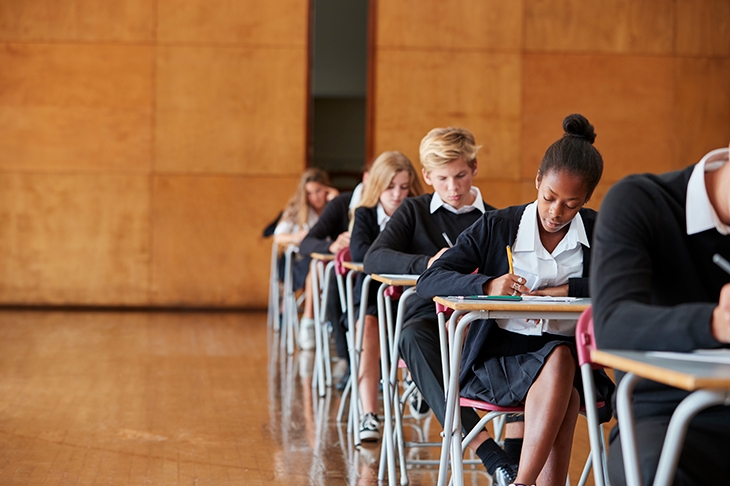It was obvious that closing schools would hit the poorest hardest, inflicting permanent damage and deepening inequality. While many private schools and the best state schools maintained a full timetable of lessons throughout lockdown, a study by UCL in June found that 2.3 million pupils — one in five of the total — did virtually no schoolwork at all during the weeks of lockdown. The official response has been to turn a blind eye, and imagine that the damage can be covered up by simply awarding decent exam results.
This year’s students are right to protest about the injustice of the system. From the moment the decision was taken to cancel exams, rather than carry out exams with social distancing, this year’s mess was guaranteed. To judge pupils on teacher assessment is now the only way to proceed. This will, of course, introduce a whole new element of unfairness, but there is, alas, no alternative.
Lockdown has reversed about a decade of progress in narrowing educational inequality
If you saw this year’s exam grades out of context, you might wonder what it was that made students so much brighter and more knowledgeable in 2020 than they were before. This year’s pass rate for Scottish Highers is 89 per cent, vs 79 per cent last year. This is the result of the Scottish government’s decision to reverse its moderation of estimated grades by the Scottish Qualifications Authority which had led to 75,000 pupils being downgraded. Initially, Nicola Sturgeon, the First Minister, had stood by this moderation process, saying results would be ‘not credible’ if there was a sudden surge of good grades. But after a week of complaints from aggrieved pupils, teachers and parents, it seems that the incredible has come to pass.
What forced the Scottish U-turn was the realisation that pupils were more likely to be downgraded if they lived in a poorer area. This has caused anxiety and fear in Holyrood and Westminster because it exposes a genuine scandal: lockdown has reversed about a decade of progress in narrowing educational inequality. Given that children are no more likely to catch or pass on the virus in schools than anywhere else, we know — in retrospect — that schools never needed to be closed in the first place. Sweden continued classroom lessons and a study showed its pupils were no more likely to catch Covid than those in Finland, where schools were closed. Teachers in Sweden proved no more likely to contract the virus than those in other jobs.
But upgrading exam results conceals, rather than repairs, the damage. Ministers talk about offering extra tuition, but the pupils worst affected will be in the hard-to-reach category, who need the daily presence of a teacher to encourage them to have faith in themselves. These are the pupils who most benefit from learning in an environment outside the home, and need daily contact with others — friends, teachers and more — who can support and inspire them. The idea that teaching is a job that can just as easily be done via set homework or a computer screen is insulting to the profession. Preparing children for exams is just one part of the job.
Inflated grades may make it easier for government and school authorities to ignore the problems which have been created by the suspension of normal school education during the lockdown. Like Nelson deliberately looking down the telescope with his blind eye and seeing no ships, they will be able to say: where is the problem, given that children are achieving better grades than ever?
The Norwegian government has calculated the cost of school closures, estimating that every week outside the classroom permanently lowers lifetime earnings. The World Bank has put a global price on it: five months of school closures, it says, cuts lifetime earnings for affected children by $10 trillion. You will not find similar studies carried out by the UK government: this is not a problem ministers wish to acknowledge, though the charity Save the Children has done impressive work calculating lockdown’s effect. Given that Labour has struggled to decide its own policy on school closures, it is unlikely to speak up for the pupils. The debate about schools reopening has tended to be all about the adults.
Grade inflation did not begin with Covid-19. It has been going on for decades. It happens because there are a great number of people who gain from it (at least in the immediate term) and rather fewer who lose from it. It allows schools to give the impression that they are offering a better education than they really are, and governments to crow about the success of their education policies. It does not only afflict schools, either — universities, too, have been blithely inflating their grades for years. In fact, it is a worse problem in universities, because there is no moderation process even in normal years — they set and mark their own exams. As a result, the proportion of students gaining a first has risen from 13 per cent to 33 per cent in the past 20 years.
What should happen now is a series of post-lockdown assessments to see which pupils have suffered most, so that schools (and ministers) know who to help, and how. This would be expensive and unpopular among teaching unions — some of which are already calling for next year’s exams to be cancelled. But the government owes it to the youngest generation to do its best to repair the damage. The work must start now.






Comments